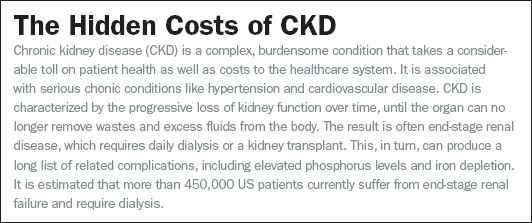A Blueprint for Launch
Breaking down the four steps to a successful drug launch, using Keryx Biopharmaceuticals’ model for Auryxia, its new treatment for chronic kidney disease.
As new drug launches proliferate in the hotly contested specialty therapeutic space, companies are finding that success is often pre-determined by actions that take place very early in the development and commercialization cycle. The vital drivers of success are (1) the quality and depth of interactions with three key influencers-clinicians, payers, and the patient-and (2) harnessing the powerful integrative effects of advanced, state-of-the-art technology infrastructure. Done right, both points can help a new medicine outperform on the timelines to market launch as well as facilitating prompt take-up by practitioners in the market place-ultimately delivering strong P&L in a business where time is money. Has anyone heard of a better source of competitive advantage than this?
One company, Keryx Biopharmaceuticals, offered to share with Pharm Exec its own set of best practices, building on the December 2014 launch of its first compound, Auryxia, developed to control serum phosphorus levels in patients with chronic kidney disease (CKD) on dialysis. The company devised an integrated four-plank strategy to accelerate its go-to-market launch date, which came only three months after the FDA approved Auryxia, on Sept. 5. It included a set of unique clinical trial designs as well as a key opinion leader (KOL) engagement blueprint designed to anticipate the likely actions of patients, payers, and clinicians as the basis for a truly differentiated positioning for Auryxia in the marketplace.

In addition, Keryx implemented new cloud-based technology to support the rollout, giving the commercial teams access to customized information and supportive analytics that tackled one of the enduring flaws in traditional launch strategies: poor alignment among internal groups that are supposed to be working together to execute around a packed timeline while being ready to react to unanticipated challenges from regulators, competitors, and environmental changes in the market.
According to Keryx President and Chief Operating Officer Greg Madison, the company began developing Auryxia 10 years ago, yet the road to getting the drug on the pharmacy shelf-the specific preparations to go commercial-was accomplished in just 10 months. "Focus and discipline were the two management principles that helped accelerate the launch of Auryxia to ensure that the thousands of CKD patients on dialysis with hyperphosphatemia have a new option to help manage their condition."
Madison highlights four process innovations that the company applied to push this new medicine to market:
√ Build a critical therapeutic niche to address an unmet need
One of the first steps Keryx took toward commercialization was surveying the physician community to uncover the needs of renal disease patients. Keryx quickly learned that good data is not enough to see uptake in the market. Instead, success starts with intelligent clinical trial design in partnership with experts and clinicians who understand the needs of patients.
Keryx strategically designed its clinical trials so it could evaluate multiple comorbidities resulting from CKD, but ultimately found that addressing a very specific unmet need within the CKD disease state would help set the company up for success and, most importantly, help patients. In this case, the niche disease area for CKD is hyperphosphatemia, or elevated serum phosphorus levels, which is often present among patients with end-stage renal disease (ESRD) since the kidneys are not able to excrete phosphate.
√ Differentiate and provide access
A core component of any biopharmaceutical company's marketing strategy is differentiation.
For Keryx, this meant honing in on a complication in a niche disease state for which there was an unmet need. Patients with CKD on dialysis often experience elevated serum phosphorus and iron deficiency. Auryxia was demonstrated to be an effective phosphate binder in clinical trials. In addition to effects on serum phosphorus levels, the pharmacodynamic properties of Auryxia has been shown to increase serum iron parameters, through systemic absorption, which is managed by the body's gastrointestinal regulatory mechanisms.
This differentiation didn't stop with brand attributes though; it was also important to consider payer and reimbursement strategies to ensure access to the product.
"We know access to medicines today is challenging, especially in the renal market. As part of our go-to-market strategy, it was imperative that we work with payers to provide patients with affordable co-pays," says Madison. "That's why each Auryxia patient will have access to the Keryx Patient Plus program-a comprehensive patient services program that offers eligible patients with financial assistance, and a dedicated Keryx case manager that provides personalized reimbursement support, including education about the co-pay and patient assistance programs."
√ Launch with a technology foundation that unites internal-external teams
Keryx began the process of building its commercial technology infrastructure with a simple goal: to enable its field teams to compile, interpret, distribute, and communicate site-relevant information to provide a differentiated customer experience. Keryx's vice president of marketing operations, Abraham Ceesay, knew that establishing its operations in the cloud would meet Keryx's needs in a cost-effective manner, while supporting global expansion and customer-centricity goals. Keryx partnered with Veeva Systems and implemented Veeva Commercial Cloud, a single solution that pulls together customer data and analyses and processes it to create a needs-appropriate platform for multichannel interactions with compliant content, all targeted to give Keryx maximum speed and leverage against the competition.
Ceesay stressed the significance of uniting sales and marketing with technology rather than implementing a system that would impede the groups from sharing information. "Freed from the burden of legacy systems, we were able to quickly set up our commercial infrastructure the right way, the first time, with input and ownership from both sales and marketing," says Ceesay. "They were in on this project from the beginning."
Veeva applications provide Keryx the advantage of a proven, life sciences-specific solution, making it quick to implement without major customization-this proved critical to meeting its aggressive go-to-market timeline. Combined, the cloud-based technology captures all customer interactions across personal and non-personal channels, providing commercial teams with deeper insights about customer targets.
"Our sales teams can hold an ongoing conversation with the customer across all channels, for a seamless customer journey. Sales representatives can follow up on conversations or start new ones seamlessly through a physician's preferred channel using the latest marketing materials without compliance risk. And the system feeds insights from the field directly to marketing, and vice versa, for harmonized, more successful selling," explains Ceesay. "Having a complete view of the customer's experience with the sales representatives, including pre-call, in-call, and post-call activities-has helped us reorient our sales force toward greater focus on customer needs."

The Hidden Costs of CKD
Eliminating the barriers between sales and marketing, Keryx's commercial cloud technology delivers a full view of the customer and enables the company to synchronize communications across channels to maximize impact and optimize resources. And, Keryx can change, upgrade, and scale the application as needed, so commercial teams remain agile and are always working on the latest innovations. Specifically, during a face-to-face visit to physicians, the sales rep is equipped to provide a full range of services immediately rather than having to follow up later. Complete results of the sales call, including any digital materials used and customer feedback, are automatically captured to update all Keryx account team members, saving time and improving collaboration. In other words, brand teams can view the interactions in the aggregate to understand the impact of messaging and related activities, quickly modifying the promotional mix as needed rather than waiting months for campaign data. The key is that customer insights are based on actual customer behavior, not derived data pulled from a survey or results from a campaign that ran last year.
√ Go to where the talent is
But technology or software is not enough without that human touch. Motivated multi-functional teams are required internally and externally to address the demands of the product on all fronts, including commercial, regulatory, medical, as well as technology.
"Keryx took many measures to assemble the right resources and people for its teams," says Madison. "As part of its approach, Keryx expanded its New York-based operations to Boston, a hub of bioscience innovation, to attract and bring together a disciplined and seasoned talent pool capable of collaborating towards its product goals. We engaged a team that had existing experience and knowledge within renal disease. This expertise will add in value to our product launch success."
Madison concludes, "The key to our winning strategy was a relentless focus on leading a niche area rather than trying to be good at everything, including training and motivating our internal associates and fostering a high-performing culture and management style to deliver quality results. Our culture and dedication to the biology of renal disease resembles the agility of a biopharma start-up, very close to its roots. We've got to stay close to the patient due to the fact that our success will ultimately be evaluated by the impact we have on people's lives."
William Looney is Pharm Exec's Editor-in-Chief. He can be reached at wlooney@advanstar.com.

The Misinformation Maze: Navigating Public Health in the Digital Age
March 11th 2025Jennifer Butler, chief commercial officer of Pleio, discusses misinformation's threat to public health, where patients are turning for trustworthy health information, the industry's pivot to peer-to-patient strategies to educate patients, and more.
Navigating Distrust: Pharma in the Age of Social Media
February 18th 2025Ian Baer, Founder and CEO of Sooth, discusses how the growing distrust in social media will impact industry marketing strategies and the relationships between pharmaceutical companies and the patients they aim to serve. He also explains dark social, how to combat misinformation, closing the trust gap, and more.